Spontaneous development of plasmacytoid tumors in mice with defective Fas-Fas ligand interactions
- PMID: 9607923
- PMCID: PMC2212316
- DOI: 10.1084/jem.187.11.1825
Spontaneous development of plasmacytoid tumors in mice with defective Fas-Fas ligand interactions
Abstract
B cell malignancies arise with increased frequency in aging individuals and in patients with genetic or acquired immunodeficiency (e.g., AIDS) or autoimmune diseases. The mechanisms of lymphomagenesis in these individuals are poorly understood. In this report we investigated the possibility that mutations at the Fas (lpr) and Fasl (gld) loci, which prevent Fas-mediated apoptosis and cause an early onset benign lymphoid hyperplasia and autoimmunity, also predispose mice to malignant lymphomas later in life. Up to 6 mo of age, hyperplasia in lpr and gld mice results from the predominant accumulation of polyclonal T cell subsets and smaller numbers of polyclonal B cells and plasma cells. Here, we examined C3H-lpr, C3H-gld, and BALB-gld mice 6-15 mo of age for the emergence of clonal T and B cell populations and found that a significant proportion of aging mice exclusively developed B cell malignancies with many of the hallmarks of immunodeficiency-associated B lymphomas. By 1 yr of age, approximately 60% of BALB-gld and 30% of C3H-gld mice had monoclonal B cell populations that grew and metastasized in scid recipients but in most cases were rejected by immunocompetent mice. The tumors developed in a milieu greatly enriched for plasma cells, CD23- B cells and immunodeficient memory T cells and variably depleted of B220+ DN T cells. Growth factor-independent cell lines were established from five of the tumors. The majority of the tumors were CD23- and IgH isotype switched and a high proportion was CD5+ and dull Mac-1+. Considering their Ig secretion and morphology in vivo, most tumors were classified as malignant plasmacytoid lymphomas. The delayed development of the gld tumors indicated that genetic defects in addition to the Fas/Fasl mutations were necessary for malignant transformation. Interestingly, none of the tumors showed changes in the genomic organization of c-Myc but many had one or more somatically-acquired MuLV proviral integrations that were transmitted in scid passages and cell lines. Therefore, insertional mutagenesis may be a mechanism for transformation in gld B cells. Our panel of in vivo passaged and in vitro adapted gld lymphomas will be a valuable tool for the future identification of genetic abnormalities associated with B cell transformation in aging and autoimmune mice.
Figures

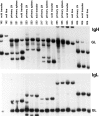
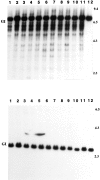
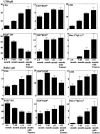
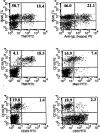
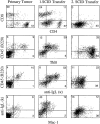

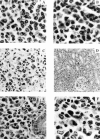


Similar articles
-
Fas-mediated cytotoxicity is not required for rejection of murine nonvascularized heterotopic cardiac allografts.Transplantation. 1998 Dec 27;66(12):1793-801. doi: 10.1097/00007890-199812270-00038. Transplantation. 1998. PMID: 9884278
-
The accumulation of B220+ CD4- CD8- (DN) T cells in C3H-lpr/lpr mice is not accelerated by the stimulation of CD8+ T cells or B220+ DN T cells with staphylococcal enterotoxin B and occurs independently of V beta 8+ T cells.Int Immunol. 1995 Aug;7(8):1213-23. doi: 10.1093/intimm/7.8.1213. Int Immunol. 1995. PMID: 7495728
-
Significant role of Fas ligand-binding but defective Fas receptor (CD95) in lymph node hyperplasia composed of abnormal double-negative T cells.Immunology. 2002 Aug;106(4):470-5. doi: 10.1046/j.1365-2567.2002.01462.x. Immunology. 2002. PMID: 12153509 Free PMC article.
-
Cellular interactions in the lpr and gld models of systemic autoimmunity.Adv Dent Res. 1996 Apr;10(1):76-80. doi: 10.1177/08959374960100011601. Adv Dent Res. 1996. PMID: 8934931 Review.
-
On the role and significance of Fas (Apo-1/CD95) ligand (FasL) expression in immune privileged tissues and cancer cells using multiple myeloma as a model.Leuk Lymphoma. 1998 Nov;31(5-6):477-90. doi: 10.3109/10428199809057607. Leuk Lymphoma. 1998. PMID: 9922038 Review.
Cited by
-
A portrait of the Bcl-2 protein family: life, death, and the whole picture.J Clin Immunol. 1999 Nov;19(6):365-77. doi: 10.1023/a:1020598632068. J Clin Immunol. 1999. PMID: 10634210 Review.
-
Alterations of Fas (Apo-1/CD95) gene in cutaneous malignant melanoma.Am J Pathol. 1999 Jun;154(6):1785-91. doi: 10.1016/S0002-9440(10)65434-X. Am J Pathol. 1999. PMID: 10362803 Free PMC article.
-
CCR2-dependent recruitment of macrophages by tumor-educated mesenchymal stromal cells promotes tumor development and is mimicked by TNFα.Cell Stem Cell. 2012 Dec 7;11(6):812-24. doi: 10.1016/j.stem.2012.08.013. Epub 2012 Nov 15. Cell Stem Cell. 2012. PMID: 23168163 Free PMC article.
-
The combined risks of reduced or increased function variants in cell death pathway genes differentially influence cervical cancer risk and herpes simplex virus type 2 infection among black Africans and the Mixed Ancestry population of South Africa.BMC Cancer. 2015 Oct 12;15:680. doi: 10.1186/s12885-015-1678-y. BMC Cancer. 2015. PMID: 26458812 Free PMC article.
-
Anaplastic plasmacytomas: relationships to normal memory B cells and plasma cell neoplasms of immunodeficient and autoimmune mice.J Pathol. 2010 May;221(1):106-16. doi: 10.1002/path.2692. J Pathol. 2010. PMID: 20217872 Free PMC article.
References
-
- Watanabe-Fukunada R, Brannan CI, Copeland NG, Jenkins NA, Nagata S. Lymphoproliferation disorder in mice explained by defects in Fas antigen that mediates apoptosis. Nature. 1992;356:314–317. - PubMed
-
- Takahashi T, Tanaka M, Brannan CI, Jenkins NA, Copeland NG, Suda T, Nagata S. Generalized lymphoproliferative disease in mice, caused by a point mutation in the Fas ligand. Cell. 1994;76:969–976. - PubMed
-
- Suda T, Takahashi T, Goldstein P, Nagata S. Molecular cloning and expression of the Fas ligand, a novel member of the tumor necrosis factor family. Cell. 1993;75:1169–1178. - PubMed
MeSH terms
Substances
LinkOut - more resources
Full Text Sources
Other Literature Sources
Molecular Biology Databases
Research Materials
Miscellaneous

